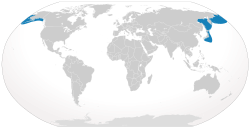Japan
The occurrence of North Pacific right whales in Japanese waters appears to show several patterns. Historic and modern sightings appear to occur more frequently in three areas: (1) the north, particularly north of Hokkaido, (2) along the coasts of central Japan, and (3) among Japan's southern islands, particularly the Bonin Islands.
The waters around and north of Hokkaido historically where regions where 19th century pelagic whalers hunted for right whales during summer and fall. This region and north through the Kuril Islands, the southern Sea of Okhotsk and Kamchatka were feeding grounds for the right whales. Some of the recent sightings of right whales off Japan are consistent with this pattern.
Right whales were formerly abundant off the coast of northeastern Japan where there have been a few sightings in recent years including observations from ICR research surveys (single animals confirmed off Kushiro, Hokkaido, in September 2002 [120] and off the Pacific coast of Honshu in April 2003). [121] Local fishermen have regularly seen a few animals per year in the area (personal contact). There is one unconfirmed sighting off the Shiretoko Peninsula in 2008. [122]
A breaching right whale was observed during a sightseeing cruise off the Shiretoko Peninsula in July 2013 making it the first confirmed sighting in the area for several decades and the first recorded in Hokkaido. [32] [123] A right whale, most likely the same individual, was seen in the area for the following two weeks until a pod of local killer whales came back to Shari coasts. The observer noted many of local tour-operating boats cruising at high speeds did not seem to detect the whale resting on water surface and forced the right whale to submerge quickly to avoid collisions. In 2018 and 2019, additional sightings have been made from the west coast of the peninsula. 2018 sighting and one of two sightings in 2019 have been made by the same tour operator, Doutou Kanko Kaihatsu (Corporation) (jp:道東観光開発). [124] [125]
The occurrence of right whales along the coasts of central Japan appears to reflect the migration of right whales past these points. There are some locations along the Pacific side of Honshu where sightings are particularly more common; from south of Tokyo Bay to all around the Izu Peninsula, from the Izu Islands to the Bonin Islands, the Kii Peninsula, Cape Muroto and adjacent waters. In the first area, there was one entanglement freed alive in April 2000 off Tateyama, and two strandings at Izu Ōshima in 2002 and 2005.
Some right whales still migrate south along Japan's coasts particularly the Pacific side of the archipelago, but what portion of the southward migration passes Japan is unknown.
The occurrence of right whales among the southern Japanese islands suggest that a wintering ground may occur around there.
An 18 m (59 ft) right whale was entangled off Kamogawa coast in May, [126] but escaped while another 15–18 m (49–59 ft) carcass was seen floating off Cape Nozaki. [127] A right whale of 10 m (33 ft) was sighted on January 28, 2014, making it the first record in the East China Sea in the 21st century. [128] One whale about the same size entered the port of Ushibuka, Kumamoto on March 28, 2014. [129] [130]
In addition, possibly two different animals were seen off Bonin Islands on 12th [131] and 25th [132] March 2014. Later one was larger, and was curious towards whale-watching vessels. [37] The whale was observed interacting with a Humpback whale. Izu and Bonin Islands are regions with highest confirmed sightings and strandings rates among tropical regions in the past century. In 1993, [133] Yasuhiro Morita of Ogasawara Diving Center succeeded in encountering right whales on four occasions near the Bonin Islands.
Most of recent sightings have occurred along the Japanese coast. Historically, right whales may have wintered in the East China Sea from the Ryukyu Islands to south of China including Taiwan though there is little scientific evidence supporting this idea. Modern sightings in the East and South China Seas, or Yellow and Bohai Seas are very rare, and the number of records is small. [134] [135] Only a few confirmed sightings in the area have occurred, and all the 5 records in the East China Sea in the last 110 years were recorded only on Amami Ōshima island and with Sukomobanare Island. [33] [126] [136] [137] [138] Additionally, all of the modern records of right whales on mainland coasts of China were concentrated on the island of Haiyang in northern Yellow Sea. [139]
Right whales may have wintered in the Bonin Islands, but few sightings in recent decades support this idea. [109] The Ogasawara Whale-watching Association reported seeing 3 groups of 4 different right whales in the Bonin Islands in the 1990s (two animals from different groups were photographed and recorded on underwater video); [140] [141] A pair of possible right whales were seen migrating south outside the port of Aogashima in December 2007. [142] Another group of 2 or 3 animals appeared just off Mikura island in March 2008. [143] One animal was sighted very close to shore in Niijima, 2011 (later described). A small right whale was seen nearby Manazuru Peninsula on April 3, and one or two right whales were sighted off Miyake Island on April 21, 2016. [144]
Off the Kii peninsula, there was one sighting in June 1999, one mortal entanglement in April 2003, and three records of two animals in the spring-summer 2006 (both from many whale watching vessels). [145] [146] [147] [148] [149] [150] [151] One of these whales was very active. A right whale escaped alive from a fishing net near Taiji Town in January 2009, [152] [153] [154] [155] a very close observation during whale watching tour (later described) in April 2011. An individual was sighted off Kushimoto within a pod of rough-toothed dolphins in February, 2016. [156] Off Cape Muroto, two entanglements (both escaped safely) were reported in February 1971 [157] [158] [159] and February 2008. [160] Two adults stranded in the northern and southern Ibaraki Prefecture in 2003 [161] and 2009. [162]
Modern sightings in the Japan Sea are very seldom made. Some strandings were reported from the 1970s to late 2000s, but none of the possible sightings of right whales were published or confirmed. Whaling of right whales continued until 1978 in the Sea of Japan. [163] A photo of a Right whale being hunted in 1922 in the Sea of Japan is available. [164]
Unusually high numbers of right whales were recorded off Japan from February to mid-April 2011. One mature female of 18 m (59 ft) body length was stranded on the Shimoda coast on the southern Izu Peninsula. [165] Carcass of this individual was not covered by barnacles. [166] It had been previously sighted off Inatori, and another animal was sighted very close to shore off Inatori again. A photo and a video are available. [167] [168] Another possible right whale was observed just outside a port in Manaduru in May (no photo was taken). [169]
In the Izu Islands, one whale was observed very close to shore, tail-slapping for an extended period of time. [48] [49] [170] [171] No photo of its head was taken.
Off Kii Peninsula, in April 2011, the same whale-watching operator who had encountered two right whales in 2006 had a very close encounter with a right whale. This whale was very curious and active; it swam around a vessel for more than 2 hours, displayed all the aerial actions several times (breaching, spyhopping, tail-slapping, pec-slapping) alongside the vessel, and the vessel had to cruise away from the whale because it kept following the vessel. Many professional whale photographers were on this tour, some of them were also on the board when this tour operator during the 2006 sightings. [172] [173] [174] [175]
Some whale watching or touring companies have encountered with several right whales or on several occasions such as several companies associated with Ogasawara Whale Watching Association (four animals in the 1990s), Nanki Marine Leisure Service (three animals in 2006 and 2011), Mikura Island Tourism Association (two whales in 2008), Godzilla-rock cruise (Gojira-iwa kankō) and its subsidiary, Shiretoko Fox Cruise since the 2000s (more than three times at least), Heritage Expeditions (at least three whales in the 2010s).
A young right whale was killed when it entangled itself in a net off Ōita Prefecture in March 2011. [176] In fact, this was reported by a biologist who saw a right whale's meat being sold at a local market, later reported to a local aquarium.
A sailor on a yacht had a very close encounter with a cow-calf pair breaching off Miura Peninsula in the earlier 2000s. This sighting was later confirmed by a local marine biologist working at an aquarium. [177]





















